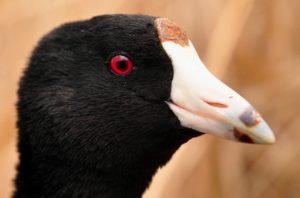Photography courtesy of Lowell Washburn, all rights reserved.
Enough is enough. No more denial. No more looking over my shoulder. Right here and right now, I’m going to come clean. And although I’ll likely be banned from future DU banquets and other outdoor social events, I’m going to admit — Well, I’m going to admit that I shoot coots. Sometimes I shoot lots of them. Not only that — but I also pick the birds up, take them home and eat ‘em.
There. It’s finally all out in the open. I am an unabashed Coot Shooter!
Everyone already knows, of course, that the lowly coot [a.k.a. mud hen] is totally inedible. Coots feed exclusively on mud. Therefore, coots taste like mud. This is common knowledge. Just visit any duck camp, sports shop or Main Street coffee shop, for that matter, and ask the first person you see if coots are good to eat.
“What, are you nuts?” they’ll respond. “Don’t you know that coots taste just like mud?” Follow up by asking these same culinary experts when was the last time they ate either coots or mud, and all you’ll get in return is a blank stare.
Enough nonsense. Here are the real facts. Coots don’t eat mud. Coots are, in fact, delicious. Even when prepared by an inexperienced cook; coots are still delicious. Too bad the species has been victim to such an undeserved reputation. No gamebird is more maligned, misunderstood or thoroughly underutilized. In the North, coots are treated with outright distain. Virtually no one bothers with them. In the South, coots are taken more seriously. Journey all the way to the Louisiana delta, and you’ll find yourself in the Coot Appreciation Capitol of the World.
Down in Louisiana, coot are known as pouldeau — a French Creole term for ’water hen’. Although there are probably dozens of excellent Cajon recipes for the the bird, coot gumbo is by far the most popular. It is also the most complicated and time consuming. On a simpler note, coots can also be used in pot pies and stew, baked with rice or oyster dressing, stir fried with vegetables, or sautéed with mushrooms, onions and peppers.
Once it’s brought to bag, no bird is easier to process than a coot. Simply make a single cut at the lower end of the keel, slip your first two fingers under the hide and pull upwards. In the time it takes to read this sentence, you’ll be done. Finish by removing fillets from breast bone. Before cooking, I usually refrigerate the meat in a dry zip lock bag with no water or marinades. During fall migration, foraging coots become hog fat. The fat is edible, but nobody — myself included – really needs it. Once meat is thoroughly chilled, I remove all fat with the dull side of a butter knife.
Regardless of which recipe you choose, there is but one hard and fast rule for preparing coots – DO NOT overcook! Treat coot breasts the same as you would your favorite steak. If you like your grilled ribeye medium rare, then that’s how coot breasts should arrive at the table. Cook them all the way through and they’ll be ruined — just like your steak would be.
If you’re still skeptic, here’s what I suggest. After safeguarding your image with a proper disguise, go to your favorite marsh, collect a few coots, and then try this simple home taste test. After bringing chilled breasts back to room temperature; season, press and sear meat in a hot oiled skillet. Reduce heat to medium; add minced garlic, butter and some chopped portabella. Cook until mushrooms are soft and meat is medium rare. Serve alone or with rice. That’s all there is to it; an incredibly simple recipe that a child could master. Here’s the fun part. In spite of negative preconceived notions, I’ve yet to find a single person who doesn’t think this recipe is melt in your mouth delicious. I’ll defer to that familiar 1970s catch phrase — “Try it. You’ll like it”. 



 Tom Cope
Tom Cope Sue Wilkinson
Sue Wilkinson Susan Judkins Josten
Susan Judkins Josten Rudi Roeslein
Rudi Roeslein Elyssa McFarland
Elyssa McFarland Mark Langgin
Mark Langgin Adam Janke
Adam Janke Joe Henry
Joe Henry Kristin Ashenbrenner
Kristin Ashenbrenner Joe Wilkinson
Joe Wilkinson Dr. Tammy Mildenstein
Dr. Tammy Mildenstein Sean McMahon
Sean McMahon